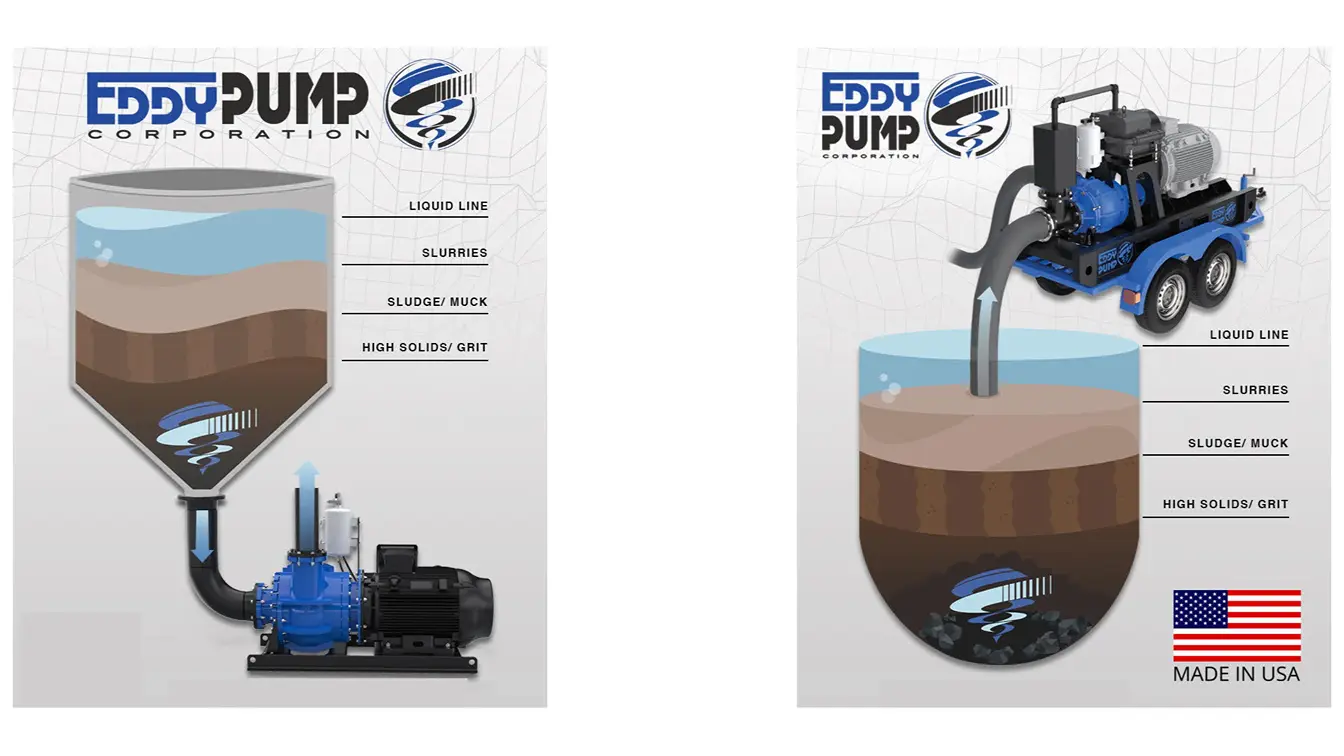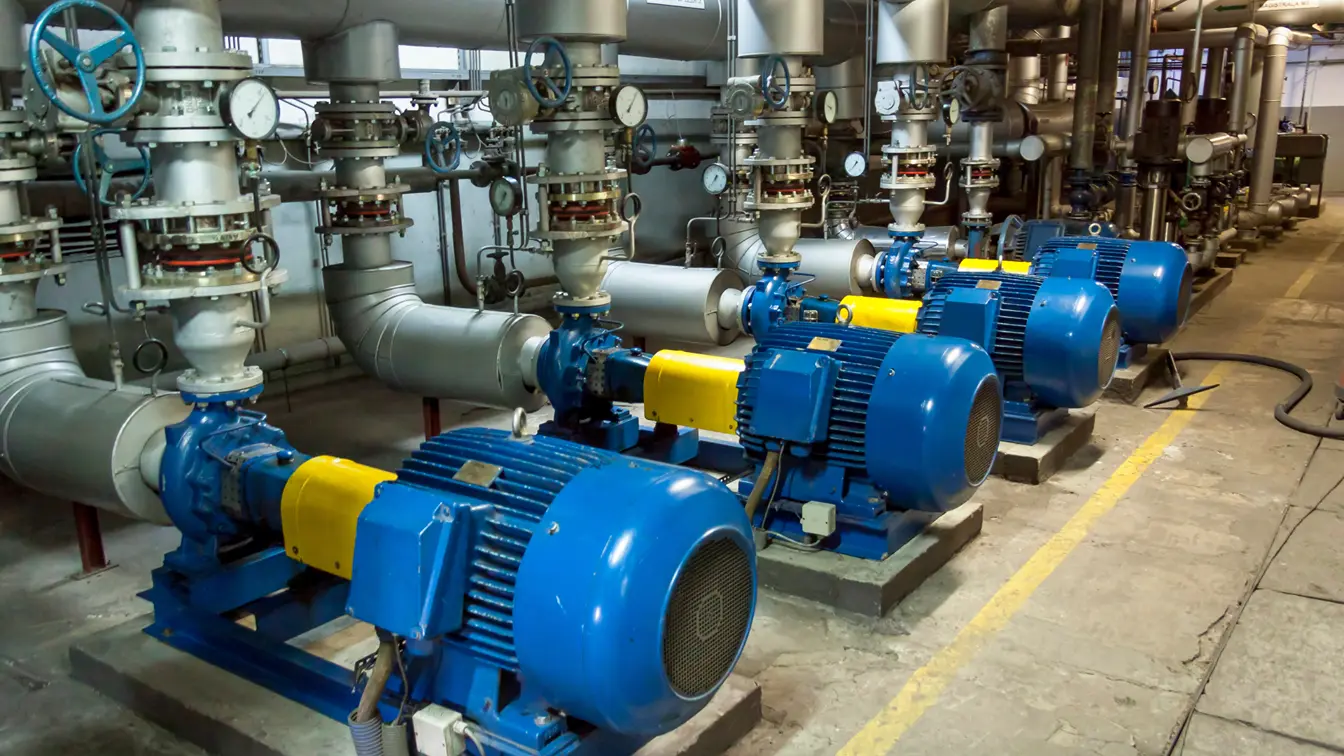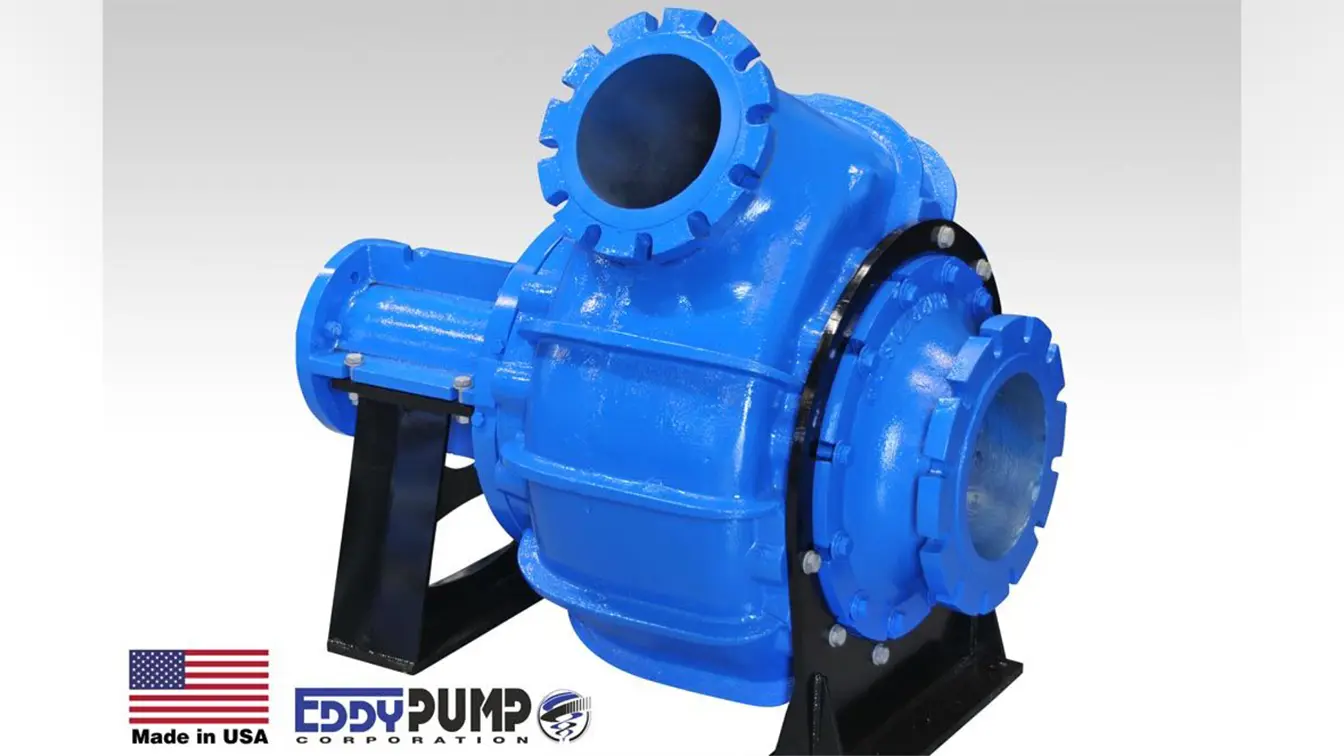
In fluid handling, where efficiency and reliability are crucial, non-clog pumps stand out as dependable allies against the challenges posed by abrasive and viscous materials. EDDY Pump leads the charge in advancing fluid technology, reshaping industrial pumping solutions. As we explore non-clog pumps, we journeyed through the core of fluid engineering, examining their types, applications, and benefits.
Non-clog pumps, especially non-clog centrifugal pumps, significantly advance fluid handling. Unlike traditional pumps, these are crafted with specialized designs to prevent clogs, ensuring continuous operation even in harsh conditions. Their unique configurations enable efficient fluid transfer and handling of solids, slurry, and debris, making them indispensable across mining, wastewater treatment, construction, and dredging industries.
The importance of non-clog technology in pumps cannot be overstated. In industries where downtime is unacceptable, the ability to maintain continuous operations under challenging conditions is invaluable. Non-clog centrifugal pumps offer precisely that, with their sturdy construction and clever design, reducing the risks of blockages and abrasion. By minimizing maintenance needs and maximizing uptime, they empower businesses to streamline processes, boost productivity, and achieve greater profitability.
This comprehensive guide will delve into the various aspects of non-clog centrifugal pumps. From exploring the different types available, including submersible and self-priming variants, to elucidating their applications across multiple industries, we leave every element as they are. Additionally, we will explore the unmatched benefits of non-clog centrifugal pumps, from enhanced efficiency and lower operational costs to environmental sustainability and more. Ultimately, you will deeply understand non-clog pump technology’s transformative role in industrial fluid handling.
As we embark on this journey into non-clog centrifugal pumps guided by EDDY Pump’s expertise, prepare to witness the fusion of innovation and reliability in fluid dynamics.
Non-Clog Pumps: Comprehensive Overview
Non-Clog Centrifugal Pump
The non-clog centrifugal pump is designed to handle fluids with solids without clogging. Unlike standard centrifugal pumps, which are meant for clear liquids, non-clog centrifugal pumps can pass solids through their pumping system, making them ideal for applications involving muddy, sandy, or sludgy waters.
Definition and Basic Operation Principle
A non-clog centrifugal pump operates on the basic principle of centrifugal force. Fluid enters the pump impeller along its axis, is accelerated by the impeller, and is thrown radially outward into a diffuser or discharge casing, converting kinetic energy into pressure. The unique design of the impeller blades allows solid particles to pass through without lodging in the pump, preventing clogging.
Common Designs and Features
Standard designs of non-clog pumps include open, semi-open, or vortex impeller configurations. These designs minimize hydraulic losses and reduce the risk of clogging. Features such as ample clearance between the impeller and the casing and wear-resistant materials also contribute to their ability to handle solids effectively.
Non-Clog Sewage Pump
The non-clog sewage pump is precisely engineered to pump sewage and effluent with solid content. It is robust and powerful enough to handle materials like tissues, sanitary items, and other debris typically found in wastewater.
Special Design Considerations for Sewage Applications
Non-log centrifugal pumps are designed for sewage applications with a large diameter impeller and a wide spiral passage to accommodate solid and fibrous wastes. These pumps may also incorporate cutting mechanisms to reduce the size of solids before pumping, further preventing clogging.
Materials Used and Durability Factors
Non-clog centrifugal pumps are constructed from durable materials such as cast iron, stainless steel, or duplex stainless steel to withstand abrasive and corrosive fluids. The choice of material depends on the application, with considerations for corrosion resistance, strength, and wear properties to ensure longevity and reliability.
Non-Clog Submersible Pump
A non-clog submersible pump is designed to operate while submerged in the fluid it is pumping. This design eliminates the need for pump housing and reduces installation space, making it suitable for deep and narrow pits.
Advantages of Submersible Designs in Non-Clog Pumps
Submersible non-clog centrifugal pumps offer several advantages, including direct contact with the pumped medium, which enhances cooling and reduces the risk of overheating. Their enclosed design protects the motor from environmental factors and allows for quieter operation than non-submersible counterparts.
Typical Use Cases and Installation Tips
Non-clog pumps are commonly used in wastewater management, flood and stormwater drainage, and industrial processes where large solid particles are present. For installation, ensure the pump is accessible for maintenance, consider a wet pit arrangement for ease of service, and use appropriate piping to handle solids effectively without additional strain.
Core Design Features of Non-Clog Pumps
Impeller Technology and Design Modifications
The impeller is critical to any non-clog centrifugal pump, including non-clog sewage and submersible pumps. The design of the impeller significantly impacts the pump’s ability to handle solids without clogging. Common modifications in non-clog impellers include:
- Open Impellers: These have open vanes on both sides, reducing clogging by allowing easy passage of solids.
- Semi-open Impellers: These compromise efficiency and clog resistance, with a back shroud that adds mechanical strength and helps handle partial solids.
- Vortex Impellers: These are designed to create a liquid vortex that allows solids to pass through without touching the impeller, minimizing wear and clogging.
These designs help maintain the flow of solids-laden fluids while minimizing the potential for blockages within the pump.
Casing Designs That Facilitate Solid Handling
The casing of a non-clog pump is designed to accommodate the passage of solids while maintaining efficient hydraulic performance. Key features include:
- Wide Volute Casings: These are used to reduce the velocity of the fluid as it passes through the pump, minimizing the potential for clogs and allowing solids to pass more freely.
- Large Discharge Outlets: These help accommodate larger solids and reduce the hydraulic losses typically associated with high solid contents.
The casing design ensures that solids are effectively transported through the pump without impacting operational efficiency.
Wear-resistant materials and Coatings
Non-clog pumps often handle abrasive and corrosive fluids, necessitating the use of durable materials and coatings:
- High Chrome Iron: Commonly used to manufacture impellers and casings for its excellent wear resistance.
- Stainless Steel: Offer corrosion resistant, making it suitable for pumping various chemical and wastewater applications.
- Protective Coatings: Epoxy or rubber linings are applied to internal surfaces to protect against abrasion and corrosion, thus extending the pump’s lifespan.
The selection of appropriate materials and coatings is essential for ensuring the durability and longevity of non-clog centrifugal pumps in harsh environments.
Sealing Systems and Their Importance in Maintaining Pump Efficiency
Sealing systems in non-clog pumps prevent the ingress of fluids into the motor and other critical components. They are vital for maintaining the efficiency and reliability of the pump:
- Mechanical Seals: These are the most commonly used sealing systems in non-clog centrifugal pumps, providing excellent protection against leaks. They can be single or double, with double seals offering additional security for handling particularly abrasive or hazardous fluids.
- Lip Seals and Gland Packing: While more traditional, these sealing methods are still used for specific applications where mechanical seals might not be suitable.
Proper sealing protects the motor, reduces maintenance needs, and ensures the pump operates efficiently by preventing fluid leakage.
Applications of Non-Clog Pumps
Non-clog centrifugal pumps, including non-clog sewage and non-clog submersible pumps, are versatile and essential in various sectors, efficiently handling fluids containing solids without clogging or losing operational efficiency. Here are critical applications across different industries:
Municipal Wastewater Management
Non-log pumps are crucial in transporting sewage from residential and commercial buildings to treatment facilities in municipal wastewater management. Their ability to handle solid wastes and fibrous materials without clogging ensures the reliability of municipal sewage systems, preventing backups and overflows.
Role in Sewage Treatment Plants
Non-clog sewage pumps are indispensable in sewage treatment plants. They are used in several stages of the treatment process, from moving raw sewage into the plant to transferring processed effluent for further treatment or discharge. Their robust design ensures they can handle the high loads of organic and inorganic solids typically found in sewage.
Flood Control Applications
Non-clog submersible pumps are extensively used in flood control applications. They can pump large volumes of water mixed with mud, sand, and debris during flooding. Their reliability and effectiveness in such conditions help quickly reduce water levels in flooded areas, thus mitigating damage.
Industrial Applications
Various industries rely on non-clog pumps for process wastewater handling and disposal. Industries such as chemical manufacturing, mining, and construction use these pumps because they can handle abrasive and corrosive fluids laden with solids.
Use in the Paper and Pulp Industry
The paper and pulp industry utilizes non-clog pumps extensively. These pumps handle pulpy mixtures and process waters that contain fibers and solids without clogging, ensuring continuous and efficient plant operations.
Applications in the Food and Beverage Sector
In the food and beverage sector, non-clog centrifugal pumps transport process waste, often containing organic and semi-solids. Their ability to handle such materials without clogging or damaging the products is crucial for maintaining hygiene and efficiency in food processing operations.
Agriculture and Irrigation Systems
Non-clog pumps are vital in agriculture for irrigation systems where water may contain mud, sand, and organic debris. They provide efficient water delivery from rivers and ponds to the fields, ensuring that debris does not block the irrigation channels or damage the pump.
Benefits of Handling Large Water Volumes Mixed with Debris
The critical advantage of non-clog pumps is their ability to manage large volumes of water mixed with varying types of debris without the risk of clogging. This capability is essential in applications such as stormwater management, flood mitigation, and other scenarios where water contamination with solids is prevalent.
Benefits of Using Non-Clog Pumps
Non-clog pumps, such as non-clog centrifugal pumps, non-clog sewage pumps, and non-clog submersible pumps, offer significant advantages across various applications, from municipal waste management to industrial processes. Here are some of the key benefits:
Increased Operational Efficiency
Non-clog pumps are designed to handle fluids containing solids without clogging, significantly enhancing operational efficiency. This ability ensures a continuous and smooth flow, minimizing downtime and the need for manual interventions. For example, a non-clog centrifugal pump can maintain a consistent output even when dealing with fluids laden with particulate matter, ensuring efficient process continuity in industrial applications.
Reduced Maintenance Costs
The robust design of non-clog pumps directly contributes to reduced maintenance costs. These pumps are less likely to suffer from blockages or failures caused by solid particles, common issues in standard pumps. Fewer blockages mean fewer breakdowns and repairs, reducing maintenance efforts and costs. Additionally, the specialized materials and technologies used in non-clog pumps, such as wear-resistant components and cutting-edge sealing systems, further diminish the frequency and cost of maintenance.
Extended Lifespan and Reliability
Non-clog pumps are built to withstand harsh conditions, including abrasive and corrosive substances. This durability extends the pumps’ lifespan and enhances their reliability. Non-clog submersible pumps, for instance, are designed to operate effectively while submerged, which protects their motors and other critical components from environmental exposure, further extending their service life and ensuring consistent performance under challenging conditions.
Environmental Benefits of Efficient Waste Management
Efficient waste management is crucial for environmental protection, and non-clog pumps are pivotal. By effectively handling sewage and waste without clogs, these pumps ensure that waste treatment processes are more efficient, reducing the risk of environmental contamination. Improved handling of waste and wastewater also means better compliance with environmental regulations and standards, contributing to the overall sustainability of operations.
Maintenance Tips for Non-Clog Pumps
Maintaining non-clog pumps, including non-clog centrifugal pumps, non-clog sewage pumps, and non-clog submersible pumps, is crucial for ensuring optimal performance and extending operational life. Here are some effective maintenance practices and troubleshooting tips:
Routine Maintenance Practices
Regular Inspection: Regularly inspect the non-clog pump’s components, such as the impeller, casing, seals, and bearings. Look for signs of wear, corrosion, or damage that could impact the pump’s performance.
Cleaning: Keep the pump and its components clean from accumulated debris and sediments, especially in non-clog sewage pumps prone to collecting fibrous and solid waste materials. This prevents blockages and maintains efficiency.
Lubrication: Ensure all moving parts, especially bearings and seals, are lubricated adequately according to the manufacturer’s specifications to reduce friction and wear.
Check Electrical Systems: For non-clog submersible pumps, regularly check electrical connections and cables for signs of wear or water ingress, which could lead to electrical failures.
Troubleshooting Common Issues
Clogging Despite Non-Clog Design: Even non-clog centrifugal pumps can occasionally experience clogs if oversized or tough debris enters the system. Check the impeller and the intake for trapped materials and clear them.
Reduced Pumping Efficiency: If a non-clog pump shows reduced efficiency, check for worn-out impellers, seal leaks, or blocked discharge lines. Replacing or repairing these components can restore standard functionality.
Abnormal Noise or Vibration: Unusual noises or vibrations can indicate misalignment, bearing failure, or an imbalance in the impeller. Addressing these issues early can prevent more severe damage.
Overheating: Ensure the pump is not running dry and check for adequate cooling, particularly in non-clog submersible pumps, where the surrounding fluid typically cools the motor.
Tips for Maximizing the Lifespan of Non-Clog Pumps
Proper Installation: Ensure the pump is installed correctly per the manufacturer’s guidelines. Incorrect installation can lead to premature wear and failure.
Use According to Specifications: Operate the pump within the specified limits for pressure, temperature, and solid handling capabilities to prevent overstressing the pump’s components.
Preventive Maintenance Schedule: Establish and adhere to a preventive maintenance schedule based on the manufacturer’s recommendations and specific operating conditions. Regular maintenance catches potential issues before they turn into major failures.
Training for Operators: Provide proper training for operators on the correct operation and maintenance of non-clog pumps. Knowledgeable handling can significantly reduce the risk of misuse and prolong the equipment’s life.
Conclusion:
Non-clog centrifugal, sewage, and submersible pumps have become essential in the fluid handling industry. They adeptly manage abrasive and viscous materials to ensure continuous operations. EDDY Pump has been a leader in this field, pioneering innovations in pump technology that enhance efficiency, reduce maintenance costs, and extend equipment lifespan across various industries. Their specialized designs allow for handling solids, slurry, and debris, making these pumps indispensable in mining, wastewater treatment, and construction.
EDDY Pump’s commitment to advancing non-clog pump technology underscores the importance of these systems in maintaining industrial productivity and environmental integrity. The broad applications and significant benefits of non-clog pumps demonstrate their critical role in modern industrial operations, offering solutions that meet the current demands and pave the way for future advancements. As industries continue to face challenging, fluid handling requirements, the reliability and efficiency of non-clog pumps from companies like EDDY Pump ensure a sustainable and profitable industrial landscape.




